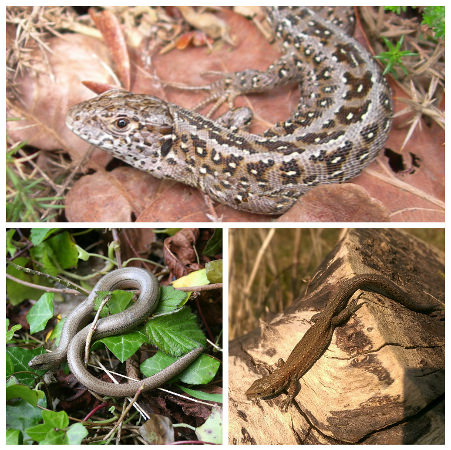The United Kingdom supports three native species of lizard, ranging from the friendly and inquisitive viviparous or common lizard (Zootoca vivipara) to the majestic sand lizard (Lacerta agilis) to the legless and secretive slow worm (Anguis fragilis).
In celebration of ‘World Lizard Day’ on the 14th August, this article provides an introduction into the life and ecology of these three species of lizards that call the UK home.
The population range of the viviparous or common lizard extends into the Arctic Circle, making this remarkable species one of the most temperature tolerant of all the lacertids. In the UK, this species is primarily a diurnal species, in other words, active during the day, and can be found in a wide range of habitats including grassland, hedgerows, woodland rides, sand dunes and brownfield sites to name a few. Relatively small in size, adults will reach up to 15-20 cm in length, with key identification features being their often uniform grey or brown colour with variable shades of brown which create linear stripes along both flanks.
Lacking any serious defence mechanisms to deal with the large number of predatory threats which occur in the UK, such as birds and mammals, the common lizard is a master of sub-caudal autotomy, when facing a threat, whereby the tail will drop off and spasm creating a few seconds of confusion when the lizards can safely scamper away.
In comparison, the sand lizard is a more specialised species. The sand lizard is on the western edge of its European range in the UK and is most likely to be found on the picturesque heathlands of the south and the dynamic sand dune systems of the north-west. In appearance, the sand lizard is stocky, will reach approximately 20-25 cm in length and will often proudly show off well-defined ocelli spots on the flanks of the body. Sand lizards present a different breeding biology from the common lizard, laying clutches of eggs in well grooved burrows, as opposed to giving birth to live young (‘viviparous’) as the common lizard does.
Moving away from the lacertids, slow worms are the UK’s only native legless lizard and member of the Anguidae family. Undoubtedly snake-like in appearance, slow worms will reach up to 40-45cm in length with fairly uniform colouration. Females can often be identified from males by the presence of a dark linear strip on either flank.
Slow worms are semi-fossorial (occupying the top soil or leaf litter) and will live fairly sheltered and almost shy lives, feeding on invertebrates, across a wide range of habitats ranging from gardens and allotments to heathland. It would not be an inaccurate statement to suggest that the slow worm is the unsung hero on the UK’s list of native reptiles, as they are potentially the most abundant species but the most understudied.
Lizards represent an important part of the ecology of the UK. They are the dragons of our landscape, they are agile predators, they are full of character, but they are threatened. They are not immune to habitat loss and fragmentation which threatens the majority of UK wildlife. It is critical that conservation schemes and development projects throughout the UK ensure that populations of common lizard, sand lizard and slow worm are at least sustainable so that future generations of people can marvel at the sight of a bright green male sand lizard grinning into the early morning sunrise.











